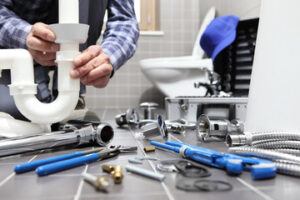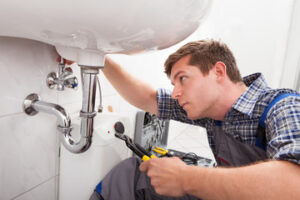Plumbers are responsible for the installation and maintenance of pipes, fixtures, and appliances. They also interpret building codes and regulations to ensure compliance.

Because plumbers frequently interact with clients, they must have excellent customer service skills. They must be able to explain complex issues in understandable terms and provide accurate estimates for their work.
Backflow is when the flow of water reverses, contaminating your clean drinking and bathing water with harmful chemicals and sewage. This is usually the result of altered pressure in your sewer or drain pipes. Fortunately, backflow is preventable. There are several ways you can keep contaminated backflow from entering your home’s plumbing, including installing backflow prevention devices and ensuring that they are tested annually.
Most people don’t think about backflow when they install a new plumbing system or repair their existing one, but it’s important to have a backflow preventer installed. This device will help to protect your plumbing from backflow and can help prevent health hazards and costly repairs in the future. Backflow prevention can also help to protect your property value and keep you safe from bacterial, chemical, and other contamination.
A backflow preventer is a check valve that allows water to flow from the community’s shared water mains into your plumbing, but it prevents the water from flowing in the opposite direction. This is necessary to avoid the risk of backflow, which can cause contaminated water to flow back into your home and create health hazards.
In addition to backflow, there are other events that could cause contaminated water to flow into your plumbing, such as pressure changes, which may occur from problems with the sewer lines or in drain pipes or from issues within your household’s own plumbing system. Common causes of backflow include irrigation systems, chemical dispensers at mop sinks and commercial dish-washers, and manufacturing processes.
Without a backflow prevention system, these contaminants can come back into your water supply and create a variety of health problems, from gastrointestinal issues to more severe conditions. In addition, contaminated water can damage your appliances and cause structural damage to your home.
There are many different types of backflow prevention devices, and a plumber can advise you on the best option for your home or business. The simplest backflow prevention method is an air gap, which simply creates a space between any device that connects to the plumbing system and the water supply pipe. More sophisticated devices, like a reduced pressure principle backflow preventer (RPBP), have a central chamber with two valves on either side, and they close when the water pressure pushes in the wrong direction.
Backflow Test Procedures
During backflow testing, the plumber checks your device to make sure it is working properly. The testing procedure consists of opening and closing valves and taking PSI readings on the device’s check and gate valves. This test ensures that the backflow prevention devices are preventing contaminated water from flowing into local clean water systems. It is crucial that you have this annual inspection performed by a certified backflow tester.
If your backflow preventer device fails the test, you must have it repaired before you can test again. Licensed plumbers will work with the city to schedule repairs and submit the necessary paperwork. They’ll also ensure that the correct procedures are followed and that all forms are filled out correctly.
While there are a variety of national manuals that have varying backflow test procedures, most cities have their own testing guidelines. It is important that your backflow tester follow these specific guidelines so that the city knows that your testing is valid.
Your backflow testing will start with the plumber temporarily disconnecting your water service. They will then identify the backflow assembly, the type of backflow preventer and its overall function and direction of water flow. They will then use a calibrated backflow tester gauge to test the device’s check valves and gate valves. Throughout this process, the tester will also take PSI measurements on each backflow device and record the results.
Once the backflow preventer passes the backflow test, your licensed plumber will reactivate your water and will then complete the necessary paperwork for the city.
Although there is nothing a property owner can do to prepare for a backflow test, they can uncomplicate their life by making sure everyone involved understands that the plumbing will be shut off. This way, people can plan accordingly or perform the necessary tasks beforehand. This also helps speed up the process as it will not be delayed. Additionally, the homeowner can hire a local backflow testing company like Kiddco Plumbing Inc. to handle the entire disconnection and submission process for them.
Backflow Test Results
Backflow tests are an important part of keeping your home’s water safe. These tests check to ensure that the backflow prevention devices (BPDs or RPZ) are working properly and are not allowing contaminated water into the public water supply. This is essential because contaminated water can come from a variety of sources, including human waste and harmful chemicals.
Backflow testing is required annually for some homes and businesses, and many municipalities require you to submit your results to your city’s public utilities department. This can be confusing, especially if this is your first time submitting test results. If you have a backflow device, here are some tips to help you understand what the results of a backflow test mean for your plumbing system.
A backflow preventer is designed to keep your house’s clean drinking water free of contaminants by blocking tainted wastewater from entering your home’s water supply during rapid changes in pressure. However, these devices can break down over time or after extreme stress events. Backflow events can be very dangerous and could contaminate your entire community’s water supplies.
While it’s never a good idea to ignore any signs of backflow, it is important to know when to call a plumber for help. If you notice a strange taste in your tap water, a rusty pipe or any other issues that affect the quality of your home’s drinking water, it’s time for a backflow test.
Other signs of backflow include water that drains slowly or has a weird smell. It’s also important to note any unusual changes in your water pressure. If you notice a sudden change in your water pressure, it may indicate that your backflow preventer needs to be repaired or replaced.
If you are a commercial or residential customer who has a backflow preventer device, it’s important to hire a certified NYC tester to test your backflow system once a year. Failure to have a backflow test performed can result in fines or even disconnection of your water service. You’ll receive a letter from the city before your backflow inspection is due. If you are unable to have your backflow inspection completed by the date provided, you can request that the city extend the deadline.
Recommendations
Plumbers make recommendations on plumbing systems and components, including new installations, repairs, and maintenance. They must be able to understand a client’s needs and provide information that helps them make informed decisions. They also collaborate with other professionals, such as architects and construction teams, to ensure plumbing work is integrated seamlessly into building projects. Moreover, they need to be able to troubleshoot and repair existing plumbing systems. This can include identifying issues such as leaks or clogs and using specialized tools to clear them.
In residential settings, plumbers install and connect pipes, fixtures, and appliances like sinks, toilets, showers, and water heaters. They work from blueprints and building plans to lay out piping and install components. They may also work on more complex plumbing systems, such as those for irrigation and fire sprinklers. They are usually on-call to address emergencies, so they must be able to respond quickly when called.
Most plumbers have a high school diploma or equivalent and receive on-the-job training through an apprenticeship program. These programs can last from four to five years and combine classroom instruction with hands-on experience. They typically cover topics like local plumbing codes and regulations, plumbing system design, pipe fabrication, and blueprint reading. Some plumbers attend vocational schools or community colleges to complete a degree program in plumbing.
Some plumbers choose to become self-employed and operate their own plumbing businesses. This can be a rewarding career choice, but it requires more time and effort than working for an employer. Self-employed plumbers often must travel between jobs and spend extra hours during off-hours responding to emergency calls.
In addition to job stability and a steady income, plumbers enjoy the flexibility of being their own bosses. They can also set their own rates and choose which projects to accept or decline. To increase their earning potential, plumbers can take continuing education courses to stay updated on new technologies and practices. They can also join professional associations and network with other plumbers to learn about job opportunities, tips on running a successful business, and ways to improve their skills.
